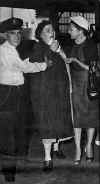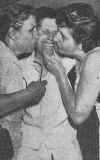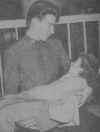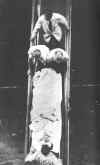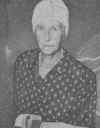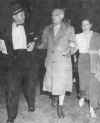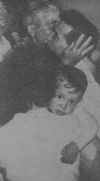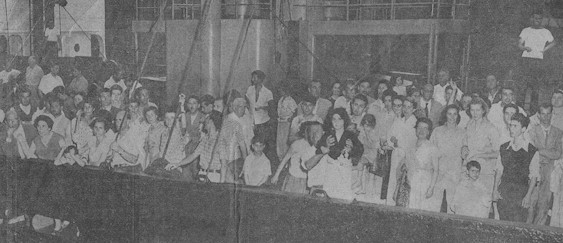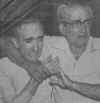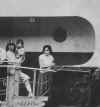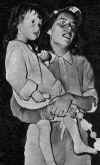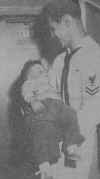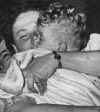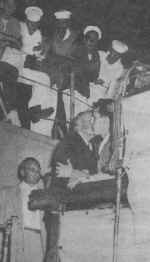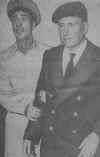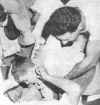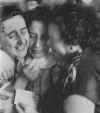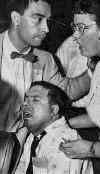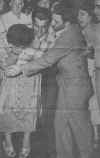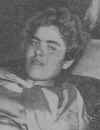New York did it big in mobilizing to receive the shipwrecked hundreds from the Andrea Doria and the Stockholm. Red tape was wiped out. Helping hands waited instead. Passports were waived, public health inspection was suspended. There was no need for customs. Medical teams, ambulances, buses, canteens, multi-lingual volunteers and loans of money were ready at North River piers and the Army base in Brooklyn as the disaster survivors arrived. A quick decision by the State Department in Washington loosened the passport requirements, and within a few minutes, Federal Immigration, Customs, and Public Health officials met at the Custom House with steamship line officers to expedite the entry of the injured, the unnerved and the anxious passengers.
Mayor Wagner and Police Commissioner Kennedy set in motion the city's facilities to ease the journey from pier to hospital or hotel or home. The Red Cross offered its disaster service and canteens. The Travelers Aid Society organized staffs of persons who speak several languages and provided money to arrange quick cash. The Italian Line arranged to announce the arrival of survivors at the piers so reunion with waiting friends and relatives would be quick. Customs officers lifted the usual inspections, requiring only that passengers sign a blank declaration as they left the piers. Realizing that many would have lost passports, Edward J. Shaughnessy, District Director of Immigration and Naturalization, announced that, aliens as well as citizens would be exempt from presenting credentials.
![]()
Ile de France
|
|
At the pier the American Red Cross, the Travelers Aid Society and representatives of the Welfare Department were on hand in force. The telephone company rigged up twenty extra telephones at Pier 88, which were addition to the seventeen permanently on the Pier. Capt. William V. Bradley, president of the International Longshoremen's Association was present when the Ile de France arrived and said that he had 500 longshoremen standing by. He said they would render free any service for which they were needed. The Italian line said It would pay all bills, including hotel expenses, of the survivors, and also promised to reimburse the Red Cross and the Welfare Department for their expenses. The survivors were disembarked on the pier's upper level. Slowly they descended, singly or two or three at a time. Cleared through a Red Cross enclosure, they went forth into a battery of floodlights and a wall of newsmen and photographers. Laughter blended with tears on the faces over 700 Andrea Doria survivors when they arrived aboard the Ile de France to join friends and relatives they thought they may never see. It was a moment when emotion, created by many hours of anxiety, burst forth like a flood. "My baby! My baby!" a mother screamed when she spied her young daughter walking unaided off the ship. Mother and daughter embraced and cried uncontrollably. The scene was repeated a hundred times as wives were joined with husbands, parents with children, brother with sister. Mrs. Angelina Guarnieri rushed forward to clasp her sister, Mrs. Benedetta De Michele, who came to the US to live with her sister. This reaction was typical of the first survivors to reach land safely. For most, the disaster was the high moment of their lives. As they left the rescue ships, many clad in bathrobes and pajamas, some with bandages, hundreds of anxious spectators pressed forward watching for a familiar face. "My husband. He's safe!" a young woman shouted, breaking through police to reach her loved one. Priests and nuns stood by reciting silent prayers as they awaited friends returning from religious pilgrimages in Rome. One nun began to bite her nails as she waited the first of more than 20 stretcher cases lifted from the Ile de France. It was 6 p.m. when the first casualty was treated. She was Mrs. Viola Gentle, seventy-five, of San Francisco. Dr. Fernando Vescia, of the Bellevue Unit, helped her to a cot, exchanged pleasantries with her in Italian. He administered a sedative noting that the elderly woman was suffering from shock. "You have money?" a nurse from Bellevue asked Mrs. Gentle. Mrs. Gentle pointed to her bosom and whispered yes. She got into a taxi and said she was going to a hotel. A moment after Mrs. Gentile was released, the first of about twenty stretcher cases started to be brought down the gangplank. By 6:30 p.m. twenty-one stretcher cases, sixteen women and five men-had been carried off the Ile and whisked away in ambulances to Roosevelt, St. Clare's and St. Vincent's Hospital. Several of them had legs or arms in casts. One woman was heavily bandaged about the head. Another injured woman was pregnant. She was accompanied by her husband, and four-year-old daughter. One injured man was in his bare feet. A Roosevelt Hospital ambulance took an entire family to the hospital: Giuseppe Napoli, his wife Rosa, and their daughter Angela,4. Giuseppe and Angela were not injured but Rosa was expecting a baby and she was suffering from shock. They would not leave her. Many of the first survivors were Italian immigrants seeing this country for the first time. Their faces showed stark fear as they stepped on the foreign soil they hope some day to call home. Unable to speak English, they gestured wildly trying to give police and first aid units personal information so desperately needed. But the Red Cross solved this by having on hand a delegation of Italian-speaking aids. Red Cross, Salvation Army and other welfare groups started the almost impossible task of locating missing relatives and outfitting those left virtually without clothes. Nicandro Caranci came here to live with a brother he has never seen. He planned to find him among the throng on a New York pier by the simple expedient of shouting the family name at the top of his lungs. But he came down the gangplank of the Ile de France to a wild, noisy scene of shipwrecked survivors instead of home coming passengers, and his simple plan failed. Italian speaking officials turned him over to the Traveler's Aid Society. Miss Eileen Sweeney checked Nicandro in a room at the Roosevelt Hotel and began a long distance hunt for Nicandro's brother. Speaking no Italian and only armed with a name and address she called three states before finding Antonio Caranci who then came to pick his brother up. "My son, he's where?" an Italian woman asked a pier
official. She was quickly turned over to one of several Italian speaking police officers
called in to ease the language barrier. Margherita Prata had no idea where her son
was. They were separated when she gave Enrico to a priest on the Andrea
Doria but could not keep up with them while fighting the crowds on the
deck. Among survivors who had managed to stay together during the rescue were John Dazzo and his bride Carmella. Laughter and tears blended as they told how their wedding trip to a home in the US had been a nightmare but "we thank God we're here at last". Mrs. Anna Coppola arrived on the Ile de France with her sons, Francesco and Fillipo. Her infant son Luigi was missing, the child was placed in another lifeboat when they left the Andrea Doria. One of the largest families to arrive was Mr. and Mrs. Ellis D. Hill and their five children including their 2 month old twins. The Paladino family was sick with worry, they did not find their four year old daughter Maria on the Ile de France and now they were in New York. They were advised to go to Pier 84 where the Cape Ann would arrive at 7:30pm. Dr. Thure Peterson reported the death of Camille Cianfarra and his two children and then sadly added that his own wife was crushed in the wreckage, died in his arms and went down with the ship. |
Many survivors departed with friends they had made while facing death together, friends they will have for life.
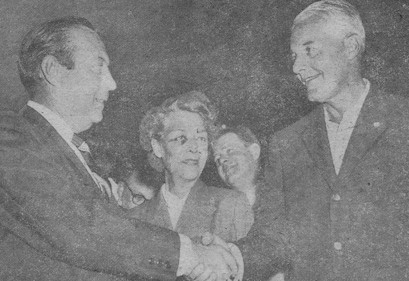
Maurice Couve de Murville, French
Ambassador in Washington, sent a message of congratulations to the Ile de
France. Captain de Beaudean read the message to the reporters in his cabin.
"I ask you to accept for yourself and transmit to the officers and crew of
the Ile de France my sincere congratulations for the magnificent
part taken in the rescue of the victims of the collision between the Andrea
Doria and Stockholm. Because of your ship, the French flag is once
more at the place of honor through an action which shows the solidarity and
courage of our mariners."
The captain added that the rescue was made possible by the discipline and
bravery of a well trained crew. "I am very satisfied with our boys, and
with the one hundred and sixty of them that manned the boats.
The Ile de France cast off her lines at 8:10 p.m. and slowly backed out into the river. Her prow swung around and once again she headed for Europe. Her part in the rescue would delay her arrival in Le Havre by at least twenty-four hours. In the words of Captain de Beaudean, "What's that compared to lives."
![]()
Cape Ann
|
Three
Italian children, separated from their parents in the sinking, arrived
on the Cape Ann in custody of crewmembers.
The youngest, Maria Paladino, 3, was accompanied by Antonio Regina, 17,
who told customs officers he had saved her from the sinking liner.
Regina related that when the ship was abandoned, he found little Maria
but could not locate her parents before he was ordered into a lifeboat.
He said he did not know her father's Christian name and had become
acquainted with them only on the ship.
Little Maria clung to Antonio while Red Cross nurses fitted her into
blue jeans, sport shirt and moccasins and protested each time the boy
tried to move away.
Regina was met by his brother Ralph Regina, who offered to take the
little girl to his home along with Antonio. Immigration officers,
however said that would not be possible and that the little girl must go
to the shelter until her family could be located.
The
other two children Vito Rizzi, About 3, and Sabina, about 5, came ashore
from the Cape Ann with crewmembers. They too were about
to be bundled off to the children's shelter, clad in brand new Red Cross
outfits, when their uncle Luigi Rizzi, of the Bronx, appeared to claim
them. The uncle explained that Vito and Sabina had been placed in one
life-boat and their parents, Giusseppe and Maria Rizzi, in another. Both
parents were injured and were taken aboard the Ile De France.
When the French line docked, the parents were sent to Roosevelt
Hospital. From there they
contacted Rizzi’s brother Luigi, who came to the Cape Ann.
while his wife rushed to the hospital.
Luigi and Michael Moscatiello are finally reunited with their mother Angela, she arrived earlier on the Ile de France.
At 9:05 pm all the survivors were landed.
Pvt. William H. Thomas
![]()
![]()
Edward R. Allen
It was about midnight when the Navy escort Edward R. Allen arrived at the
Brooklyn Army Terminal in Brooklyn with officers and crew members of the Andrea
Doria. As reporters and photographers waited, the captain conferred with
with officials of the Italian Line and the Italian government. Acting on their
instructions, the crew kept silent regarding the cause of the collision.
Only one crewmember leaked information of any importance, Cadet John Conte, he
told reporters that the radar was still functioning ten minutes after the
collision and he saw a ship about four to five miles away. This indicated that
the radar was in operation. The cadet was in the lounge when the Stockholm
struck. He then rushed to the bridge for orders and was assigned to man the
signal lights and the intercom system.
Captain Calamai was escorted from the ship, the ordeal placed a great strain on him. His brother Mario took him to his own house so he could rest.

